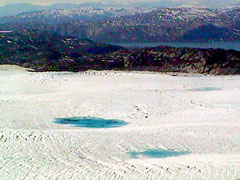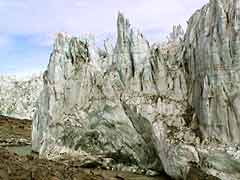|
 Student
Journalist Experience in Greenland Student
Journalist Experience in Greenland
on Her Paid
Internship!
By Eve Lamborn
It was early June and
I was shivering.
Though I was layered in my winter coat, a stocking cap and gloves,
the brisk wind set my teeth chattering. I thought of my friends
back home in Kansas, likely barricaded inside comfortable, air-conditioned
buildings away from the summer heat and humidity. But my thoughts
were interrupted by a sharp crack that echoed across the boulder
field where I was perched, followed by a deep boom, and my distant
friends were forgotten. The cold wind, after all, was blowing off
the Greenland ice sheet, and I was 60 kilometers north of the Arctic
Circle, sitting in front of a glacier that was calving huge chunks
of ice into a stream.
 I
could see a crack across the face of the glacier and it had slowly
been widening for the last half an hour, a tantalizing hint that
a big piece of ice was going to break off. Two of my companions,
an airplane pilot and a NASA scientist, had scrambled closer to
the ice for a better view, and they too had their eyes fixed on
the crack. It was going to fall any second. Of course, I had been
thinking that for thirty minutes now. I
could see a crack across the face of the glacier and it had slowly
been widening for the last half an hour, a tantalizing hint that
a big piece of ice was going to break off. Two of my companions,
an airplane pilot and a NASA scientist, had scrambled closer to
the ice for a better view, and they too had their eyes fixed on
the crack. It was going to fall any second. Of course, I had been
thinking that for thirty minutes now.
I was in Greenland as part of a science-reporting internship through
the University of Kansas. Scientists at KU have developed two types
of airborne radar to measure Greenland‚s polar ice sheet. Every
summer they travel into the field to operate their radar and gather
data, and I had the amazing opportunity to travel with them to Greenland
and accompany them on their flights.
They are studying polar ice sheets because sea levels have been
rising over the last century. Sixty percent of the world‚s
population lives in coastal areas, so rising oceans could have potentially
catastrophic long-term consequences. Scientists think melting polar
ice sheets are causing some of this rise as a result of climate
change, but much information is needed to confirm this theory and
predict what will happen in the future, and that's where the KU
scientists contribute.
Led by Prasad Gogineni, a distinguished professor of electrical
engineering and computer science, scientists at KU‚s Information
and Telecommunications Technology Center first came to Greenland
in 1993 with a radar that measures the thickness of the ice sheet.
KU graduate Pannirselvam Kanagaratnam developed another type of
radar for his doctoral thesis that maps the internal layers in the
ice sheet. He completed his doctorate in February.
Continued
Next
|
|


 Student
Journalist Experience in Greenland
Student
Journalist Experience in Greenland I
could see a crack across the face of the glacier and it had slowly
been widening for the last half an hour, a tantalizing hint that
a big piece of ice was going to break off. Two of my companions,
an airplane pilot and a NASA scientist, had scrambled closer to
the ice for a better view, and they too had their eyes fixed on
the crack. It was going to fall any second. Of course, I had been
thinking that for thirty minutes now.
I
could see a crack across the face of the glacier and it had slowly
been widening for the last half an hour, a tantalizing hint that
a big piece of ice was going to break off. Two of my companions,
an airplane pilot and a NASA scientist, had scrambled closer to
the ice for a better view, and they too had their eyes fixed on
the crack. It was going to fall any second. Of course, I had been
thinking that for thirty minutes now.